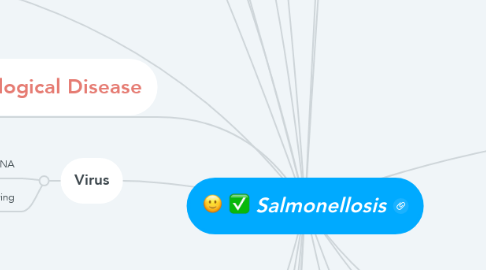
1. Virus
1.1. Hijacks living cells to recreate its DNA
1.1.1. Influenza
1.2. Is not considered Living
2. A genetic disorder is a genetic problem caused by one or more abnormalities formed in the genome. Most genetic disorders are quite rare and affect one person in every several thousands or millions. Genetic disorders may be hereditary, meaning that they are passed down from the parents' genes.
2.1. genetic diseases
2.2. Down syndrome
2.3. Hemophilia
2.4. cancer
2.5. epilepsy
2.6. heart disease
2.7. scoliosis
3. A condition which threatens a human's state of health
4. a disease caused by the lack of an element in the diet, usually a particular vitamin or mineral.
5. Infectious Disease: Symptoms
5.1. Fever
5.2. Diarrhea
5.3. Fatigue
5.4. Muscle Aches
5.5. Coughing
6. Physiological Disease
7. Deficiency Diseases
7.1. Iron deficiency
7.2. Malnutrition
8. Infectious Diseases
8.1. Pathogens
8.1.1. fungus
8.1.1.1. An organism that can be unicellular or multicellular
8.1.2. Prions
8.1.2.1. Are faulty protein molecules
8.1.3. Bacterium
8.1.3.1. Unicellular
8.1.4. Macroparasite
8.1.4.1. Usually parasitic
8.1.4.1.1. tape worm
8.1.5. How your body fights Pathogens
8.1.5.1. Phagocytosis
8.2. Infectious diseases are illnesses caused by the spread of microorganisms (bacteria, viruses, fungi or parasites) or prions to humans from other humans.
8.2.1. Strep throat
8.2.2. Virulence
8.2.2.1. The measure of how infectious a disease is
8.2.3. Flu
8.3. Infectious diseases are caused by pathogenic microorganisms, such as bacteria, viruses, parasites or fungi; the diseases can be spread, directly or indirectly, from one person to another.
8.4. flue, cold, ifluensa,momo
9. ''
10. Hereditary Diseases/Genetic Disease
10.1. This includes both Genetic and Non-Genetic Hereditary Diseases
11. Definitions
11.1. A disorder of structure or function in a human, animal, or plant.
11.2. When a person gets a disease that can effect their daily life and how they live their life.
12. Diagnosis and Symptoms
12.1. Medical diagnosis (abbreviated Dx or DS) is the process of determining which disease or condition explains a person's symptoms and signs. It is most often referred to as diagnosis with the medical context being implicit.
12.1.1. Diagnose Me | Get Possible Conditions | Symptom Checker SC - Entering Clinical FeaturesSC - Entering Clinical FeaturesSC - Entering Clinical Features
13. Bodies' Defence System
13.1. However, sometimes some virus may have a protective layer so them can break the first line
13.1.1. Or there are breaks in your skin for them to go in through
13.2. First line of defence
13.2.1. Mainly your skin
13.2.2. Hair around your eyes and nose
13.2.3. mainly your tears and wax
13.2.3.1. Catch incoming pathogens and bacteria like a net
13.2.3.1.1. sometimes may kill them
13.3. Second line of defence
13.3.1. non-specific immune response
13.3.1.1. symptoms
13.3.1.1.1. blood cotting
13.3.1.1.2. inflammation
13.3.1.1.3. fever
13.3.1.2. production of more while blood cells
13.3.1.3. Phagocytosis
13.4. Third line of defence
14. Treatment
15. Anxiety
16. Mental Health Diseases
16.1. Depression
16.2. Schizophrenia
16.2.1. Psychotic disorders
16.3. Eating disorders
16.3.1. Bulimia
16.3.2. Anorexia
16.4. Dementia
16.5. bipolar disorder
16.6. Personality disorders
16.7. Post-traumatic stress disorder PTSD
16.8. Obsessive-compulsive disorder OCD
17. Statistics
17.1. In 2017, an average of 21 Australians died from a heart attack each day,
17.2. The most rare disease in the world is progeria
17.3. There were nearly 216 million reported cases of infections of malaria all over the world, with approximately 445,000 deaths in 2016.
17.4. 51 Australians died every day from heart disease in 2017, or heart disease was responsible for a death every 28 minutes.
17.5. In 1900, the most dangerous diseases for Americans were pneumonia or influenza, tuberculosis, and gastrointestinal infections.
18. Treatments
18.1. Surgery
18.1.1. Medicine
18.2. Vaccines
18.2.1. It can cure itself over time.
